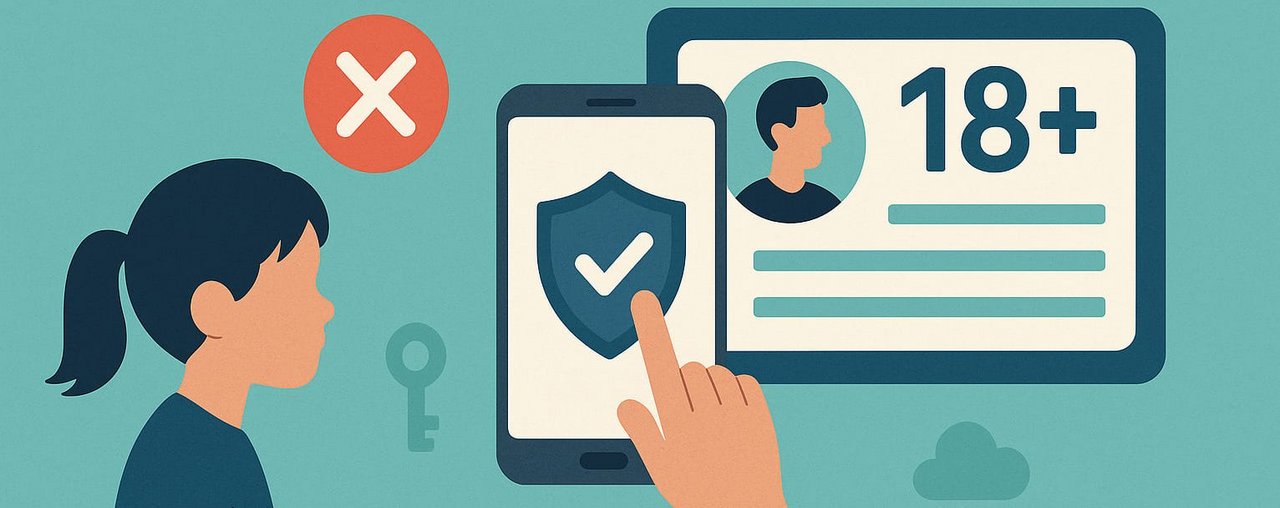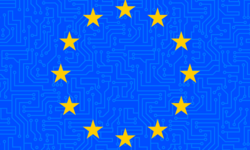
A Potential Solution to the Dilemma of Age Verification
We witness a rush to establish age verification mandates around the world from Australia to France. These systems are often poorly designed and come with huge problems for privacy, freedom of speech and the possibility of government control over peoples daily lives online. These systems rely often on government issued (digital) identification mechanisms or AI based age estimation prune to error, exclusion, discrimination and data breaches. Since our organization has long worked on digital identity, we are following this debate with increasing worry.
Instead of solving problems, currently discussed age verification measures only cover them up. The negative effect of attention-grabbing social media affect young and old users alike. Importantly, many of those negative effects are already addressed in existing digital regulation like the Digital Services Act (DSA), which prohibits advertisements targeting minors, or the General Data Protection Regulation (GDPR), which requires in many cases age of consent. Both laws provide excellent rules and significant penalties up to billions, yet the big problem is the lack of enforcement. The GDPR is in effect for almost a decade and would provide for means to penalize companies processing significant amounts of personal data from minors. Yet, the GDPR might be watered down before it was ever used to protect children. Enforcement is hard, particularly against rich, multi-national companies. This isn’t helped by the geopolitical tensions with the USA and China. But instead of facing up to this systematic failure in Europe to enforce our rules, lawmakers now want to age-gate the internet.
Yet, epicenter.works also has an educational branch with epicenter.academy and this gave us the experience of over 500 workshops for 9.103 teenagers over the past 3 years. If we ask students about their own social media consumption, many say they don’t feel good about it and are even worried what it does to them. Only a minority of students want ban social media for themselves. But when asked if their younger colleagues should be banned from using it, suddenly a majority is in favor.
I. The Authoritarian Approach
Age verification is often understood as a subset of digital identification. In these systems a user’s identity is established to derive their age from it and provide or refuse online services accordingly.
The solvable problems
Let’s start with what is easy to resolve. The verification part of age verification can be designed privacy-respecting. If the interaction between the user follows the three principles of: zero-knowledge, unlinkability and unobservability. This means that users can verify they are above or below a certain age without revealing their birth date or any other identifiable information. Every interaction is unique and prevents the verifier from correlating or tracking user behavior. Lastly and maybe most importantly, whoever provides or operates the age verification system is technically prevented from obtaining knowledge how the system is used. So the government can’t know which social media or porn websites anyone is using.
Such a system could even be used to verify age with the least trusted, most malicious or embarrassing website without risk for the user. Even when the website gets hacked they have no personal information that can lead back to the user. The European Commissions guidelines for the protection of minors do a fairly good job in implementing these three principles.
The unsolvable problems
Millions of people will be excluded from an internet that requires users to verify via identity. Not everyone has the digital ID which provides the age verification solution with the identity and birth date of the user. In fact, many people don’t have smartphones – let alone modern smartphones able to securely operate digital IDs. Taking photos of physical IDs in an App to verify identity can be faked. But more importantly, it still excludes people that don’t have identity documents. Many people will not have the digital literacy to use complex age verification solutions, particularly older generations or low-income households. Lastly, the experience from other countries demonstrates the refusal from many people to use any government system as a precondition to express themselves online. Mandatory Digital IDs are a poison pill for trust in government systems.
Easy to circumvent. Age verification mandates that are perceived as intrusive or over-reaching will lead to resentment and massive circumvention of the system. Virtual Private Networks (VPNs) or anonymisation services like Tor are quick and easy ways around them. Even the official Age Verification solution of the European Commission has no protection against a minor using the ID or Smartphone of an adult to circumvent the age check. The only effective parental controls happen on device, but more on that below. Those with digital skills always find ways around these banns and many young people are digitally savvy.
Over-identification will follow. As outlined above, a privacy-respecting age verification is technically possible. But almost all real world age verification systems relied on much more intrusive means because those are cheaper to implement and give the added bonus of valuable identity data to the service provider. Without regulation the concrete technical implementation will always follow the path of least resistance, particularly since social media companies aren’t known for their respect for our privacy. Even if such a regulation would be established, it could easily change. Once an age-verification system is rolled-out it would be a simple technical update to provide the verifier with a link to the real identity of the user. In this scenario, we would create the infrastructure to gate the entire internet, with insurmountable risks for exclusion, discrimination, surveillance and freedom of speech. In the future, it would just be the flip of a switch to exclude other groups from parts of the internet.
To be clear, we reject such an age verification solution that is linked to identity. No matter the technical implementation, the negative consequences for society at large don’t justify the potential benefits. Such systems are unworkable, dangerous and won’t improve the situation. But, we think there is an alternative worth discussing.
II. The Alternative Solution
Proposed Solution
We want to discuss a potential solution for the dilemma of age verification that strikes a better balance between the protection of children and the protection of the open internet. The general idea is instead of tying online interactions of everyone to their identity, we simply tie the devices of children to their age group. Parents or schools are usually in control of the devices of their children. They know their age and can set it up without any need for (digital) identification. What is missing is a standardized way for operating systems and browsers to communicate this information about the age group of the user to the apps and websites.
Importantly, in cases where an app or website receives such information about the age group of the user, they have to act accordingly. For example, when an adult-only websites receives such an age signal for a minor, a simple “18+” click can’t override it. Social media apps would have no excuse for targeting minors or letting them open accounts without their parents consent. It would become the responsibility – and maybe even the liability – of any app or website that would be illegal for minors in the country the request comes from to block itself to children on devices using this system. Therefore, the age signal via this API should be given legal recognition. This would help enforcement and take loopholes away from big tech.
What is required is such a technical standard to setup devices or user accounts on those devices specifically for children. Such a standard has to be inter-operable and freely licensed, because its important that also free operating systems can implement it. On Smartphones Google and Apple have both announced similar systems to comply with local legislation in the US. It seems the EU would have a strong case to develop such a standard and require its use from dominant operating systems and web browsers. Web browsers are important because websites should also receive the age signals. Technically the standard can be very light weight to also be suitable for older devices. Full support of every smartphone or desktop operating system (version) is not required, since a subset of devices suitable for children would suffice.
Finally, devices and user accounts that don’t send these age signals to apps or websites are treated no different from now. The provider of the content might assume that those users are adults, similar to the current situation. That means for the majority of users and devices on the internet simply nothing changes.
Pros and Cons of this Solution
Inclusive and realistic. The proposed solution is far more inclusive than any of the other models on the table. People without technical skills to verify their age, migrants without ID documents or people simply refusing to use a government app will not be excluded from the internet. The proposed solution is also far more realistic since all it takes is one step in the setup of a new device or user account on a supported operating system.
It will help enforce existing rules against big tech. Currently, many online platforms do not do enough to protect children and one excuse often is that they don’t know who of their users is a minor. Given the vast quantities of data and profiling underpinning the big tech business model, we do not believe them. But in the proposed solution this excuse is rendered mute. Online platforms that receive the proposed standardized age signals would know the age group of the user in a legally binding manner and they would have to act accordingly. This could help enforcement of digital rules against online platforms. Proposals for a reverse signal from the online platform to the users device already exist.
Device sharing can be easier incorporated. Each age verification solution will run into problems if the devices of parents are simply handed to children. This is a common practice that includes the risks of children accessing content that should only be accessible to adults. Also other forms of age verification have this problem, like app based models. If the operating system allows for separate accounts or children modes (like most SmartTVs or streaming apps already do), this practice can be incorporated to uphold the youth protections even in these scenarios.
Parents and other guardians need to take active roles. One counter argument to the proposed solution might be that it requires parents or legal guardians to take an active role in the digital life of their child. The account setup is a necessary step for the whole system to work. In theory, the maintenance could further be reduced if the system increases the age group automatically on the relevant birthday of the child, if the clock of the system can’t be changed by the user.
Age appropriate content is often relative. Legal and cultural frameworks for youth protection vary greatly around the world, within Europe and even between states. While there are clear adult only sites, the majority of user generated content is hard to categorize. Fixed age barriers rarely account for the individual development of children and young adults. Any technology that tries to limit access will fail at the edges. At best the guardians can decide together with their child what is appropriate and technology empowers them to personalize online experiences accordingly.
Proliferation beyond big tech should be voluntary and based on open standards. It is vital for this system to be to the benefit of Europe that the underlying standard is developed most transparent, inclusive and as light weight possible. The burden on the side of the operating system and browser vendors should be minimal as to increase compatibility and also make it possible for small and medium size companies to incorporate the standard, also in patched operating systems or on devices without proprietary frameworks like Google. Nevertheless, older operating systems and devices with longer update cycles might take some time until they adopt the new system. But dominant products on the market or the ones catering specifically to children should comply with the standard.
Circumvention after a certain age or skill set is inevitable. As long as the parental controls that limit which apps to install and what to do on a children device are in effect, the proposed solution will hold. But there will be ways around the proposed solution for users with a certain digital skills set. Either booting a non restricted operating system, obtaining admin privileges to create a non restricted user account, using alternative browsers, stripping the age signals from the network transmission or using a VPN or Tor are functioning circumvention strategies. But most of these strategies are also ways to get around the authoritarian approach to age verification. Young people will eventually find ways to do what’s prohibited to them. This is not an argument against age restrictions, but a cautionary perspective on the effectiveness of every solution to them.
Clear Scope: This system would protect children from seeing content prohibited to their age group. The proposal doesn’t attempt to prevent adults from pretending to be children online, a problem hard to fix since guardians always have control over the ID documents of their children. The proposal also gives no assurances about the age of users not using the system, since that is simply out of scope. To conclude, this proposal attempts to solve the one problem most people might agree to: protecting children online is a worthy goal and doing so on the device based on an interoperable standard that empowers parents and obliges content providers. We believe this is the most sensible and the only workable approach.
Where to go from here?
We publish this post well aware about the controversy of the issue and after repeated calls from other organizations and politicians to do so. We acknowledge the brilliant work that outlines the risks inherent to this problem. But we believe that doing nothing is no longer a politically viable option. We invite feedback and scrutiny to these ideas either privately or publicly.
Since you're here
… we have a small favour to ask. You want to keep a close eye on the government? You want to stay up-to-date on surveillance, privacy, net neutrality, and all matters related to your fundamental rights on the internet? Subscribe to our newsletter and approximately once a month, we will send you a message (in German) about everything that happens around digital policy in Austria and in Europe, about our actions, legal analyses and position papers.
Together, we defend our fundamental rights in the digital age – because civil society works! Stay informed!






![[Translate to English:] [Translate to English:]](/fileadmin/_processed_/4/7/csm_DALL_E_2025-02-04_09.51.55_-_A_minimalist_illustration_of_abstract_steps_in_subtle_shades_of_yellow_and_blue_inspired_by_the_colors_of_the_EU._The_steps_are_geometric_and_abstract_d784bb3846.jpg)
![[Translate to English:] [Translate to English:]](/fileadmin/_processed_/4/b/csm_mind-the-gap-1876790_1280_ff91489141.jpg)